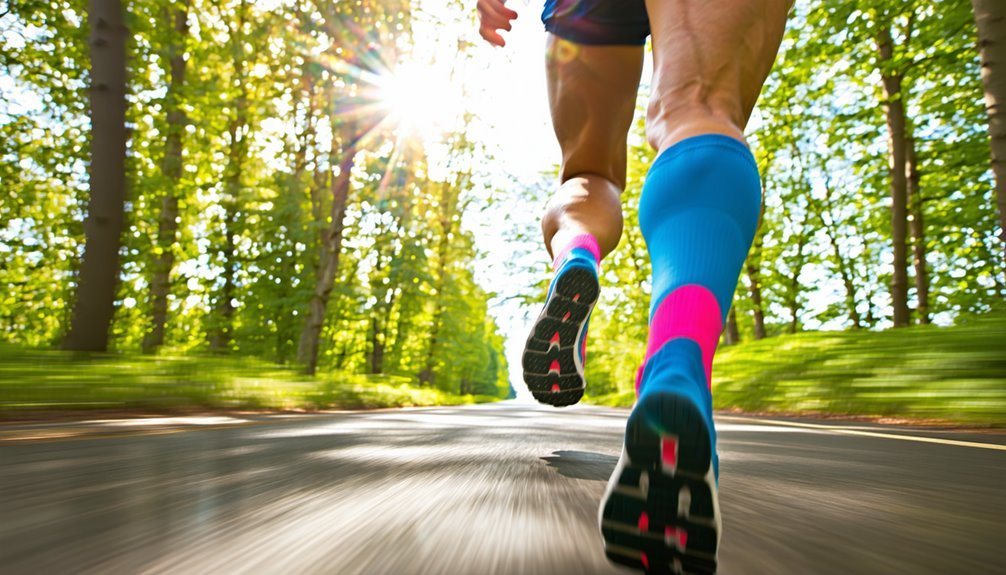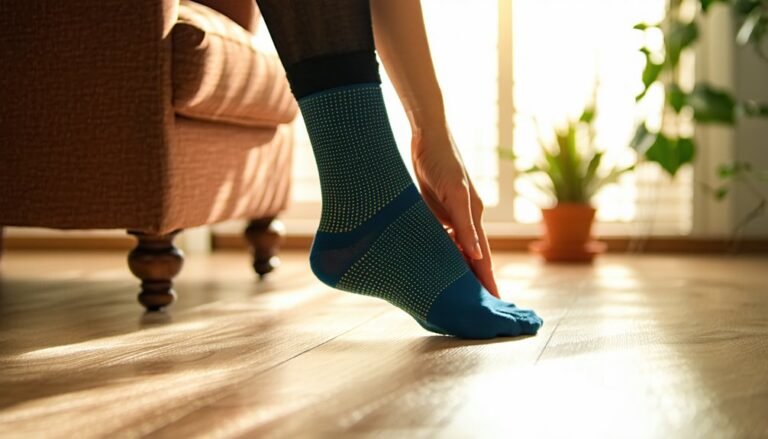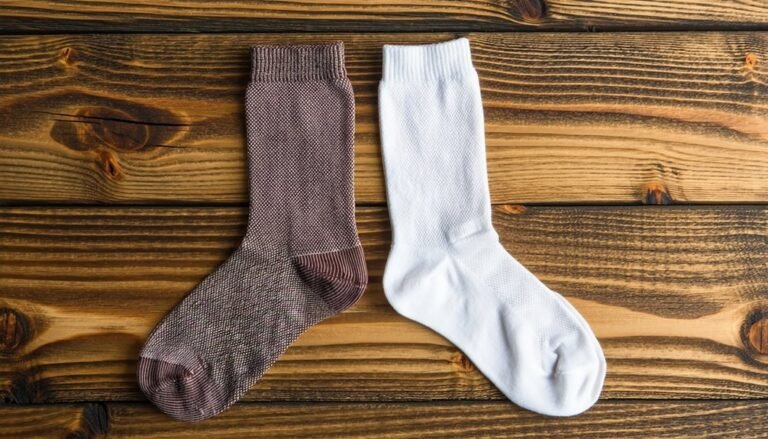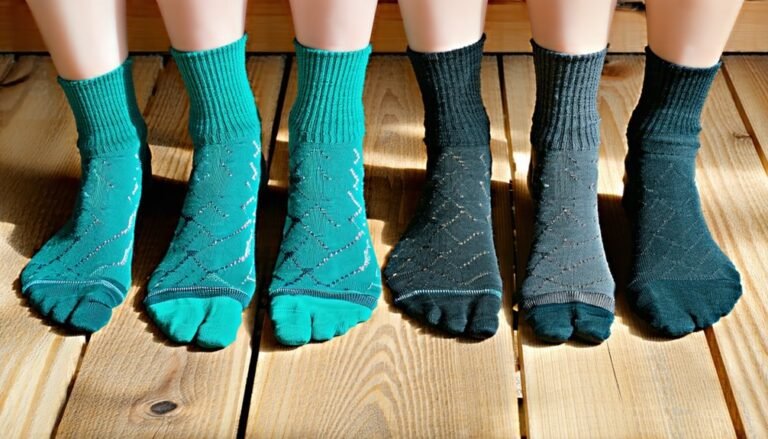Can You Wear Compression Socks While Exercising?
Yes, you can wear compression socks during exercise to enhance performance by improving blood flow and muscle oxygenation. These socks apply graduated pressure to boost circulation, aiding in nutrient delivery and waste removal. The right fit and breathable materials are key to preventing overheating and discomfort. Incorrect sizing might lead to circulation issues, so ensuring the appropriate compression level is critical. Understanding proper use will help you maximize the benefits of compression technology.
Understanding Compression Technology
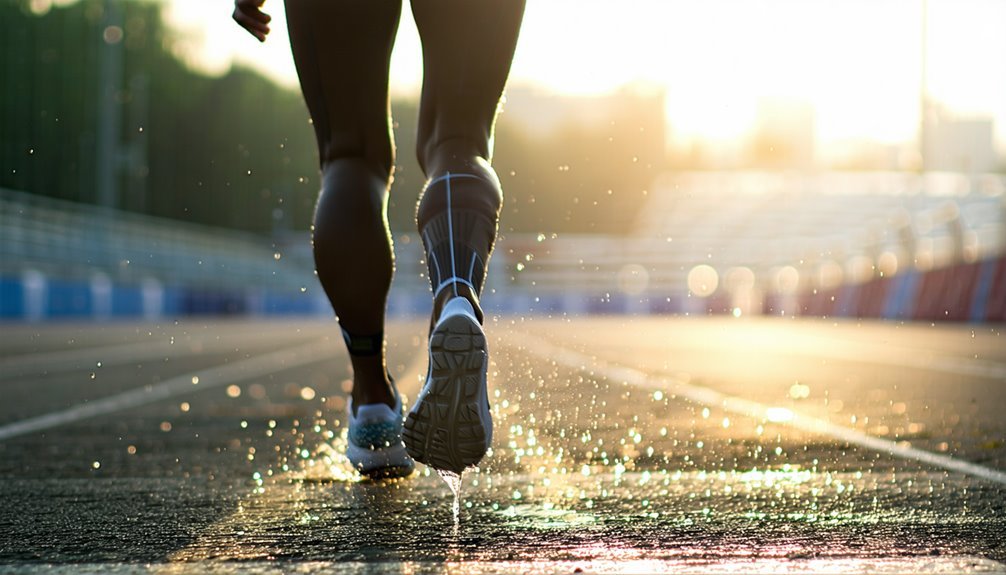
Although compression technology might seem complex, it's grounded in fundamental principles of physics and human physiology. Compression mechanisms work by applying graduated pressure to the leg, which promotes venous return and reduces blood pooling. This is achieved through carefully designed sock materials that exert specific pressure gradients, higher at the ankle and decreasing upward. Understanding these mechanisms is essential for ensuring your safety and maximizing therapeutic benefits.
Experts emphasize that sock materials—often a blend of synthetic fibers like nylon and elastane—are engineered to maintain consistent pressure while allowing breathability and moisture-wicking. This combination is important for comfort and preventing skin irritation. When choosing compression socks, consider the material's durability and elasticity, as these factors directly impact the sock's effectiveness and your overall safety.
Benefits of Wearing Compression Socks During Exercise
Wearing compression socks during exercise offers numerous advantages, enhancing both performance and recovery. By applying graduated pressure to your lower extremities, these socks facilitate improved circulation, ensuring an efficient blood flow. This mechanism not only delivers essential nutrients to muscle tissues but also accelerates the removal of metabolic waste, promoting muscle recovery. A study in the *Journal of Sports Medicine* confirms that athletes experience reduced muscle soreness and swelling.
| Benefit | Mechanism | Outcome |
|---|---|---|
| Improved Circulation | Graduated compression | Enhanced blood flow |
| Muscle Recovery | Efficient nutrient delivery | Reduced soreness |
| Reduced Swelling | Waste removal | Accelerated recovery |
| Performance Boost | Oxygenation of muscles | Increased endurance |
| Safety Assurance | Stabilization | Injury prevention |
Potential Drawbacks to Consider
While compression socks provide several benefits during exercise, it's important to evaluate potential drawbacks. Compression socks, if too tight, can exacerbate circulation issues rather than alleviate them, particularly if you have pre-existing vascular conditions. It's vital to guarantee the socks fit properly to prevent restricted blood flow, which could lead to leg discomfort or even numbness. The discomfort levels may also rise if the material is not breathable, causing overheating or excessive moisture build-up. According to experts, improper sizing or material choice might result in increased friction and skin irritation, which could detract from your overall performance. It's advisable to consult a healthcare professional to assess your specific needs and guarantee your safety while using compression socks during physical activities.
Choosing the Right Compression Socks for Your Workout
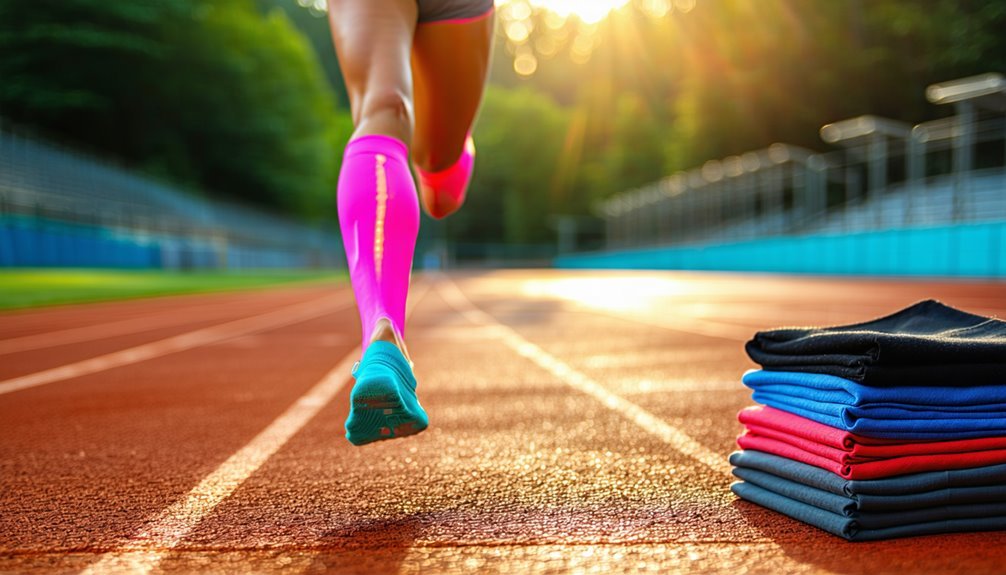
Selecting the ideal compression socks for your workout can greatly impact your performance and comfort. When choosing compression socks, consider the sock materials, as they play a significant role in moisture-wicking and breathability. Opt for materials like nylon or spandex blends, known for their durability and elasticity. Correct sizing is essential; overly tight socks may restrict circulation, while loose ones won't provide adequate support. Follow sizing guidelines based on your calf circumference and shoe size for peak fit and compression levels. Experts recommend a graduated compression of 15-20 mmHg for moderate support during exercise. Prioritize socks with reinforced heel and toe areas to enhance longevity. By adhering to these considerations, you can guarantee safety and efficacy in your workout regimen.
Tips for Incorporating Compression Socks Into Your Fitness Routine
After selecting the right compression socks for your workout, integrating them into your fitness routine can enhance both performance and recovery. Start by identifying the compression sock styles that best suit your activities. Graduated compression socks, offering tighter support at the ankle and decreasing pressure up the leg, are ideal for running. For cycling, opt for styles providing moisture-wicking materials to maintain comfort.
Incorporate them gradually, especially if you're new to wearing compression gear. Begin with shorter sessions to assess fit and comfort. Experts suggest wearing them during your workout and for 30 minutes post-exercise to aid in workout recovery by promoting circulation and reducing muscle soreness. Always monitor for any discomfort or skin changes, ensuring your safety remains a top priority.
Frequently Asked Questions
How Do Compression Socks Affect Blood Circulation During Exercise?
Compression socks enhance blood flow during exercise by applying pressure, improving venous return, and reducing muscle vibration. This can lead to improved exercise performance and reduced injury risk, ensuring a safer workout experience. Evidence supports their effectiveness for various activities.
Can Compression Socks Help With Muscle Recovery Post-Exercise?
Compression socks can enhance recovery speed by reducing muscle soreness post-exercise. Studies suggest they improve venous return and decrease inflammation, leading to faster recovery. Confirm proper fit to avoid compression-related complications and maximize their benefits safely.
Are There Any Risks of Wearing Compression Socks Too Tightly While Working Out?
When selecting compression socks, guarantee compression levels aren't excessively tight. Overly tight socks can restrict circulation, increasing injury risk during exercise. Proper fit is essential for injury prevention, supporting ideal blood flow and muscle stabilization during workouts.
Should Compression Socks Be Worn for Specific Sports or Activities?
Why wouldn't you want to maximize performance? Compression socks' benefits include enhanced circulation and reduced muscle fatigue. They're especially effective in endurance sports like running and cycling, where consistent support and recovery are essential for safe, ideal performance.
How Long Can Compression Socks Be Worn After Exercise?
After exercising, you can wear compression socks for a post-exercise duration of 1-3 hours. This optimizes recovery benefits by enhancing blood flow, reducing muscle soreness, and preventing swelling. Always prioritize comfort and consult a professional for personalized advice.

